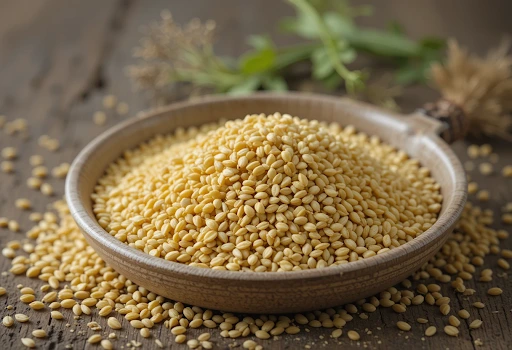Fennel Seeds and Anise Seeds
Fennel Seeds and Anise Seeds
Fennel seeds are an indispensable ingredient in many savory and sweet dishes, both sweet and savory alike. You can use whole or ground seeds for maximum flavor enhancement; to maximize this process, toasting is recommended to bring out their full potential.
Fennel is widely recognized for its ability to aid digestion. Additionally, it contains antiseptic, analgesic and anti-inflammatory properties; plus galactagogue effects which help promote breast milk production.
Differences
Fennel seeds and anise seeds are two popular cooking ingredients found throughout Middle Eastern, Indian, and European cuisines. Both possess an aromatic sweetness with notes of aniseed that lend them well for both sweet and savoury applications, including drinks.
Fennel seeds can also be added to soups and stews, curries, fish dishes and potato- or lamb-based side dishes, including Italian sausages. Pickles made with them can also be enjoyed toasted and sprinkled over vegetables or meat for extra pronounced flavour; cakes containing them also feature their deep sweetness while they can even be combined with other spices and herbs to form spice mixes such as the Chinese five-spice powder or Indian panch phoran blends.
Healthwise, fennel seeds have long been associated with digestive benefits. According to medical science, they have the power to ease bloating and gas symptoms while simultaneously reducing inflammation levels in diabetics. In fact, their consumption may even help manage blood sugar levels more effectively.
Fennel seeds may help nursing mothers produce milk more easily. If you are having trouble breastfeeding, try drinking a tea infused with fennel seed to stimulate mammary glands and increase supply.
Similarities
Fennel seeds and anise seeds are closely related, leading many chefs to use them interchangeably in classic European recipes. Both varieties boast sweet liquorice-like notes while coming from separate plants: Fennel is found growing from bulbs that can be eaten or used as herbs; while anise comes from evergreen plants.
Fennel seeds contain an ingredient known as anethole which stimulates the secretion of digestive juices and enzymes to aid in digestion, reduce bloating and improve overall digestion. They also contain various antioxidants which act to neutralise free radicals thus decreasing oxidative stress risk and chronic disease risk.
Researchers who studied mice treated with dextran sodium sulfate-induced colitis discovered that fennel seed extract could protect colonic epithelial barrier function and integrity more effectively than its control counterparts, leading to softer stool samples with more normal transepithelial electrical conductance resistance (TEER) of colonic tissue permeability.
India traditionally utilizes whole fennel seeds as an after-meal digestive and breath freshener (saunf). Their powder forms part of many popular Indian spice blends such as panch phoron and chaat masala; as well as in a refreshing drink known as saunf water that promotes healthful skin throughout the year, particularly helpful during hotter seasons due to its natural cooling properties that help prevent heat exhaustion, dehydration and other health concerns.
Culinary Applications
Fennel seeds add an anise-like aroma and flavor to culinary creations, often found in Indian curry powder, Italian sausage and Middle Eastern bread recipes, fish dishes, seafood recipes as well as homemade herbal tea. Not only can fennel add delightful taste but it can also act as an effective digestive aid and breath freshener!
As a spice, turmeric can be used whole or ground into a fine powder and added to both savory and sweet dishes alike. Useful uses for this spice include adding it to roasted vegetables and fish dishes, herb rubs or marinades, breads or pastries as well as herbal tea recipes as it can alleviate bloating, gas and heartburn after meals.
Fennel seeds provide high amounts of potassium, Vitamins A and C and calcium while being an excellent source of dietary fiber. Fennel pollen is collected from fennel flowers and often used to decorate salads or add depth to soups and stews with its distinctive floral, sweet aroma reminiscent of licorice and citrus notes. Toast or use raw for adding subtle sweetness when used on roasted vegetables, fish, chicken or meat dishes.
Substitution
Fennel seeds are an exceptional ingredient with distinct flavors and may help support a healthy digestive process. If you do not have this ingredient readily available, there are alternative solutions that provide similar health benefits.
Anise seeds, smaller and stronger than their fennel counterparts, work perfectly in dishes requiring mild anise flavoring. You can replace one teaspoon of anise seeds for every teaspoon of fennel seeds used; caraway seeds also make an effective replacement, though you should reduce their amounts by half for optimal results as their stronger flavor makes their replacement harder to incorporate.
Both fresh and dried leaves of fennel can be used in place of its seeds for recipes that call for more of an aromatic punch. Leafy fronds make delicious additions to soups, stews and salads while the bulbous root can be roasted and added to sauce-based foods such as marinades and curries – its licorice-like flavor works particularly well when combined with legumes such as beans and lentils. Furthermore, Fennel can also be found as an ingredient in various liqueurs such as Sambuca or absinthe.
If a recipe calls for fennel seeds and you don’t have any, cumin seeds provide an acceptable substitute. Their warm and earthy flavors resemble that of fennel’s and can easily be swapped out without altering the original dish. For an aromatic flourish, toast cumin seeds before including them.

